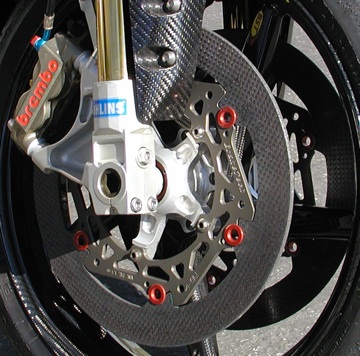Du behöver inte ha den lättaste hojen för att vinna, är du bara tillräckligt bra på att köra så räcker det.
Helt rätt, men jag förstår faktiskt inte vad den självklara slutsatsen har i tråden att göra.

...alla vet att en lätt hoj är bättre än en tung men det är lite mer komplicerat än vad du verkar vilja förstå.
Berätta vad det är som är ”lite mer komplicerat”, som inte tas upp i Fast Bikes artikel och som jag inte förstår. Var konkret och berätta.
http://www.bikehps.com/PDFFiles/BST/FastBikes_oct09_bst.pdf
”All too many folks get giddy with horses running around their heads and chuck-on an exhaust system to remedy the gallops. But is, let’s say, 10bhp going to shave seconds off your lap time? No, probably not. Especially with a litre bike, where
there’s already enough power and not enough control. Time to get scientific.
The aim is to back-to-back the R1’s standard wheels with the carbon BSTs, to see if the
£2k asking price is warranted. To keep things superfair, we used a brand-new set of Bridgestone BT-003 RSs for each set of rims, and limited laps to ten each. Fastest time wins. Before starting, it’s essential to note that we fitted Akrapovic Evolution cans and a Y-piece to the Yammy. This semi-system retails at
£1,300 and brought 4bhp to the show: I don’t care if you’re name is Valentino Biaggi or Nori Spies.
You ain’t going to shave seconds with that measly gain.
Being truthful,
I was sceptical about the advantages of the carbon rims, particularly at a circuit like Castle Combe. In the past, regardless of a stopwatch, they’ve performed beautifully at silken-laced Tarmac tracks, but their lightweight nature and stats shouldn’t be able to show true potential at the bumps of Combe. Or could they?
Matched-up against the standard R1 wheels, the BSTs weigh less than half. Lighter wheels mean less unsprung weight, which automatically reduces the moment of inertia. This is the science-scmience behind weightloss and tells us how much effort is needed to actually spin the wheel. Also needing to be illustrated is the fact that
each kilo of unsprung weight lost will equate to 5kg off the rest of the bike: hence the dramatically improved feel and handling.
Senare:
Everything takes less effort.
You can turn-in later because you can turn-in quicker, and with finer precision.
You can let off the brakes earlier, in order to carry more midcorner speed and let the bike run-in. The R1’s cross-plane crank
feels lighter and crisper on corner exit, and
the rear wheel is more sensitive to throttle movement: almost like playing an amusement arcade game. It all makes sense. The science is working. This all ties together to make a very handsome 1m14.5s lap: a difference of 1.6 seconds in favour of the carboners, and all without playin with a single suspension setting to better suit the new wheels.
Over one and a half seconds is
a huge amount. Those who have chased lap times will know.”





 ) dra igång R6an???
) dra igång R6an???








